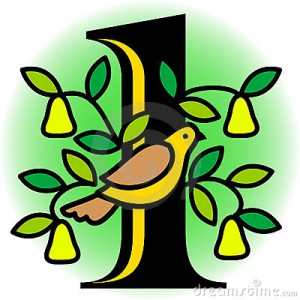The traditional Advent calendar consisted of 25 days. Advent (from the Latin word adventus, meaning “coming”) is a season in the Christian church of expectant waiting and preparation for the celebration of the Nativity of Christ, in other words, the period immediately preceding Christmas.
So what was the ‘12 Days of Christmas’ and where did it come from? Celebrated since medieval times, the ‘12 Days of Christmas’ traditionally began the day after Christmas Day and ended with Twelfth Night. Twelfth Night was the day that all decorations were to be removed because it was thought that leaving the decorations up would cause a disaster.
People believed that tree-spirits lived in the greenery (holy, ivy, etc.) they decorated their houses with. The greenery was brought into the house to provide a safe haven for the tree-spirits during the harsh midwinter days. Once this period was over, it was necessary to return the greenery back outside to release the tree-spirits into the countryside once again, or they would cause mischief in the house. Failure to do this would mean that vegetation would not be able to start growing again (spring would not return), leading to an agricultural disaster. Today some people still feel superstitious about leaving the Christmas decorations up after Twelfth Night.
The 12 days of Christmas were filled with merry-making, dancing, and continuous feasting. These days were a most welcome break for the workers on the land, which long ago was the majority of the people. All work, except for looking after the animals, stopped for those days. The Christmas season used to last much longer than that (until February 2), but people wanted the peasants to get back to work earlier, so the festive season was shortened, ending on Twelfth Night. The first Monday following the 12th day was called Plough Monday, because it was the time the farm workers were expected to return to the fields.
There is great debate as to the meaning of the carol, “The Twelve Days of Christmas” which became popular at the Twelfth Night parties that took place to end the Christmas season. A popular theory states that the song dates back to the time when Roman Catholics were not permitted to practice their faith openly (1558 until 1829). The song was written as a way of teaching young Catholics and had two levels of meanings: a surface meaning and a hidden meaning known only to their church. Each element in the carol has a code word for a religious reality, which the children could remember:
The ‘true love’ of the song refers to God.
‘A partridge in a pear’ tree was Jesus Christ.
‘Two turtle doves’ were the Old and New Testaments.
‘Three French hens’ stood for faith, hope, and love.
‘Four calling birds’ (actually the birds were colley birds or blackbirds) were the four gospels of Matthew, Mark, Luke, and John.
‘Five golden rings’ recalled the Torah or law, the first five books of the Old Testament.
‘Six geese a laying’ stood for the six days of creation.
‘Seven swans a swimming’ represented the seven gifts of the Spirit which are the motivational gifts of prophecy, serving, teaching, exhortation, giving, administration, and mercy found in Romans 12:3-8.
‘Eight maids a milking’ were the eight beatitudes of Matthew 5.
‘Nine ladies dancing’ were the nine fruit of the Spirit: love, joy, peace, patience, kindness, goodness,faithfulness, gentleness, and self control found in Galatians.
‘Ten lords a leaping’ were the ten commandments.
‘Eleven pipers piping’ stood for the eleven faithful disciples.
‘Twelve drummers drumming’ symbolized the twelve points of belief in the Apostle’s Creed.
So how do we transform this to make it a reminder of the birth of Jesus Christ?
Modern day marketing may think they are taking Christ out of Christmas, but He is so woven into the fabric of the season that they are up against an impossible task. Jesus IS the reason for the season, and this is ‘His Story’. Jesus is in the lights…the candy cane…the carols…the gifts…the trees…the mistletoe…the tinsel… and the seemingly secular song of “The Twelve Days of Christmas.” When you hear or sing the song this season, think of what the Catholics meant with the symbolism and remember Romans 11:36 For of Him and through Him and to Him are all things, to whom be glory forever. Amen
Jesus’ birth is a time for for being merry and celebrating, but it doesn’t need to end after 12 days. Let’s celebrate Jesus’s coming 365 days!!

